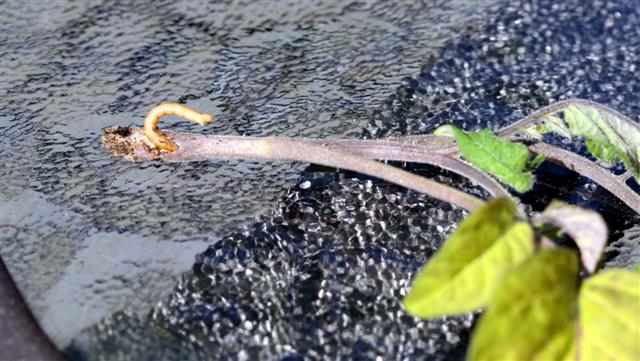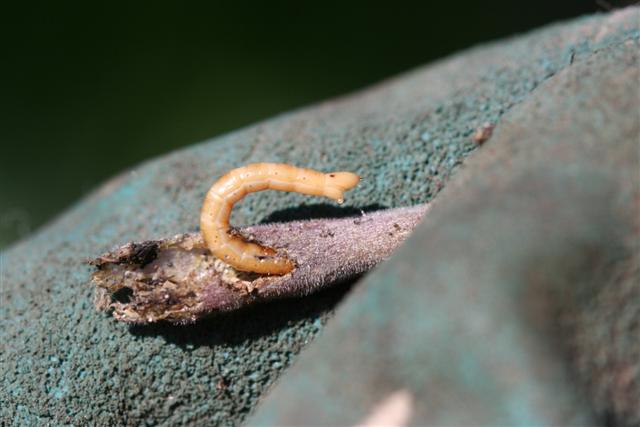Update: This post is from May when I found wireworms eating my tomato plants. If I had prepared some traps in March these could have been saved. Plan now, save your plants too. Don’t let the wireworms win.
Finally some nice weather has me outside to check on my newly transplanted early tomatoes and…WHAT THE?!
The wilty and pale sad little transplants looked perfectly healthy 2 days ago.
I pulled one up to replace it with a backup and WHAT THE %$^&%$%^&*?! There’s wireworms eating them from the inside out.

I think this one is actually drooling….

I dug around in the soil only to find a whole bunch of these ugly critters. I had planted lettuce transplants early in the season in the same raised bed which all mysteriously disappeared days after planting. I blamed the slugs. I killed LOTS of baby slugs to terrify the other hidden slugs. But could it have been these nasty little wireworms that ate my lettuce?
If you recently transformed a grassy part of your yard to a garden bed (check out Turning Lawn into a Vegetable Garden with Raised Beds) then you may have an abundance of wireworms just waiting for tender seedlings. The best way to remove them is by setting up a wireworm trap.
Cut a potato in half and skewer it with a long stick. Bury the potato in the soil (or make a few of these for large beds/lots of wireworms), ensuring that the top of the stick stays above the soil so you can find them. In a week or so, carefully dig (not pull) up the trap and remove the wireworms. Replace and keep removing the worms until you don’t find them anymore. You are now ready to plant!




Oh no! What a drag, I’m so sorry! It’s too early to have to deal with this level of combat!
I am glad to see you back in blogging action, though!
I hope the yam/potato/carrot thing will do the trick. I’m forwarding your post to my “garden guru” friend Bev to see if she has any other info or tricks up her sleeve.
In the meantime, keep fighting and keep the back-ups handy! (and maybe prep a new pot / container with new potting mix?) Good luck!
Hello-
Gory looking little devils!
Wireworms are larvae of the Click Beetle who behaves like a Mexican Jumping Bean when disturbed. It is a brown,3/4″long, shiny-coated beetle.
I have also seen the potato idea used against assorted underground assailants, but I don’t know if it’s directed specifically at wireworms. I believe you place a cut potato underground near the afflicted plants and wait a few days. Remove and destroy the potato, then replace it with another.It acts like a “trap crop” except it’s underground. If you forget to remove it, you’ll be growing potatoes as well as over-feeding the pests.
Planting smaller seedlings with a collar of aluminum foil or cardboard, partially submerged, tends to deter cutworms (not sure about wireworms). I also read that a long, thick pine needle, inserted right against the young stem, prevents the cutworm from getting his body wrapped around the trunk of the seedling to begin the destruction. I have tried this and did not have cutworm damage, but must say they are not prevalent in my gardens. Cutworms often hide nearby, just below the soil surface, and can sometimes be scratched up with a hand cultivator and killed when suspected of causing damage to seedlings.
Those wireworms may have come with the seedlings from the nursery. (?)
If you are inundated, perhaps a drench of Beneficial Nematodes may help. They are a natural mercenary organism who go after a few dozen pests including FLEA LARVA. I use them against Iris Borers.
http://www.arbico-organics.com/category/beneficial-nematodes
Above is one of several links..
Good Luck! It’s not too late to seed more tomato plants. You’ll have later fruits, but that’s better than no fruits.
Oh my gosh that is so frustrating! I just found aphids all over the place yesterday and feel like I’m at war now. grrr.
I agree with the consensus,you have yourself some wireworms. They are a weird little worm that when turned upsidedown flip back over with an audible click. The adult form is the click beetle.They cause no damage to the garden. It’s offspring are a different story. The adult lays it’s eggs in the soil, especially around grasses. The larvae then takes 3-6 years to develop to adults. They feed close to the soil surface in spring and move deeper into the soil as it warms. They surface again in the fall, and go deep once more as the soil cools. They can move long distances sideways through the soil as well.
Wireworms bore into all variety of plants. From tubers, corms, especially large seeds (corn,peas,beans), into the crowns of plants like lettuce. They are particularly damaging to potatoes, dahlia’s, gladiolus and small plants. Large plants may die from disease organisms that enter the damaged roots through the wireworm damage.
They can be most noticable in the years after sod is first turned to make garden beds. Although the spread of introduced species of wireworms throughout the lower mainland has made them a problem in regularly cultivated soils as well.
As for prevention:
-Plant as late a possible in spring to avoid wireworms. Start Dahlias and other susceptible plants in pots and plant them out later.
– Where they are a serious problem, don’t grow fall rye cover crops, which attract wireworms. Legume cover crops are less attractive to, but can still sustain wireworms.
– Keep empty garden bed weeded all winter or use leaves, or straw mulch. Empty mulched beds usually have fewer wireworms in the spring than beds with crops or weeds.
-Plant plenty of extra seed, especially large seeded crop to avoid heartache at the losses from these buggers.
Control:
-Physical removal. Turn over the soil in annual beds several times before planting and pick out any wireworms that turn out. They are hard to crush. Warm soapy water is recommended.
-Traps. The ones mentioned above with carrots and potatoes work well. Use a skewer and place the vegetable chunks a few inches under the soil. Pull the traps every day or two and destroy. Use both potato and carrot, as different species of wireworm have different preferences.
-Trap crops. There is some success with luring wireworms to germinating seed. Starting with bare soil, thickly sow rows of wheat or barley. Sow the trap seeds 10 days before you want to plant the garden. When the seeds have germinated, pull th seedlings and destroy
The insect parasitic nematodes available are not effective against wireworms, and I wouldn’t recommend using them in this case.
All of my info came from the West Coast Gardening: Natural Insect, Weed & Disease Control book by, Linda A. Gilkeson, Ph.D. It is one of the books you will get in the course next year. I think it’s fantastic your going to sign up! Maybe we will get to work on some Master Gardener projects together in the future!
I hope this helped!
So sorry to hear about your wireworms. I get them on and off in the beds, but never enough of them to do real damage.